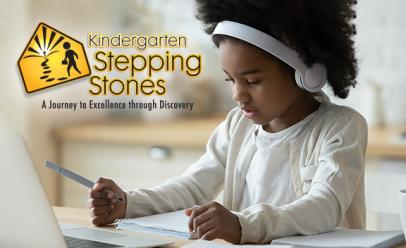 By: Kendall Hunt RPD with contributions from the editorial team of Kindergarten Stepping Stones
By: Kendall Hunt RPD with contributions from the editorial team of Kindergarten Stepping Stones
Several months into remote or hybrid learning, you might be looking for ways to shake things up a bit, especially those of you who teach the youngest (and most wiggly) students. Even if you’ve heard them before, a little reminder could spark a new idea, so here are four tips for teaching kindergarten in a hybrid/remote setting, plus notes on how our Kindergarten Stepping Stones program can help!
Take advantage of location
Instead of lamenting the fact that the kids aren’t together, many teachers this year have gotten creative in utilizing their students’ remote learning environments. For example, kindergarten teacher Zachary Steen of Bentonville, Arkansas, asks his students to give daily weather reports from their home, in which they take the computer to the nearest window and describe what they see.
KindergartenWorks.com includes scavenger hunts and I-spy in its list of activities kindergarteners can do (almost independently) online. They also propose asking students to document their household chores, take pictures of their room and write about it, or “teach” a sight word to a stuffed animal or family pet.
Kendall Hunt Connection: Kindergarten Stepping Stones is built around monthly themes, correlated with our Pathways2.0 program, that focus on helping students learn from their environments; the themes “Deep in the Forest” and “Brr! It’s Cold!” are prime examples. All ten units are full of hands-on activities easily adapted to students’ home environment, and more importantly, they direct students’ attention to that environment—and the hand God had in creating it.
Emphasize relationships
It’s no secret that kindergarteners need social interaction with peers to put their learning into context. “They learn through groups; they learn from the teacher, meetings, socializing, and sharing,” said Jennifer Becthle, a kindergarten teacher in Eatontown, New Jersey.
That type of interactive learning can be difficult now because student interactions are more limited due to the need to practice social distancing. “I miss the students getting to play with kids from other classrooms,” kindergarten teacher Stephanie Nash told the Kendall Hunt Religious Publishing Department (RPD) team. “That is something that we did, especially in grades PreK–2, and that isn't happening at all.”
Knowing this, educational outlets have encouraged teachers this year to focus on relationships with their virtual kindergarteners. Whether that involves creating prompts for students to discuss with their families, setting up breakout rooms where children can chat, or scheduling one-on-one meetings with each student to check in, socialization in a virtual kindergarten classroom needs to be intentional.
Kendall Hunt Connection: We’ve said it before, and we’ll say it again: when you build a curriculum around faith, relationships are an integral part of it. Each Kindergarten Stepping Stones theme also has a spiritual connection, teaching children about their relationships with God (“God Loves Me”), their peers (“God Gives Us Friends”), and their relatives (“God Gives Us Families”). As a natural part of the learning process, students grow in relationships, whether in the classroom or virtually.
Lean on repetition and schedules
Although it may seem tempting to provide a myriad of virtual activities to prevent boredom, repetition and predictability are actually a young student’s best friends.
“Kindergartners delight in repetition in the form of songs, rhymes, chants, and games,” wrote Tara Bardeen, a Denver-based literacy advocate and former classroom teacher, in a blog for WeAreTeachers. “Repetition also helps boost their confidence and their understanding of new concepts,” she noted.
Bardeen encouraged teachers to stick to predictable schedules and repeat songs, rhymes, and games, ideally with movement involved because kindergarteners enjoy hands-on learning and interactive play. Although this can be hard in a virtual classroom, songs and rhymes with set movements that anyone can do in their bedroom, living room, or kitchen can be a good way to keep students engaged, active, and focused.
“This year more than ever, I am asking myself how many skills/concepts can be taught or reviewed using an animated video or a fun song,” said Nash. “[Students] LOVE it, and it's a research-based practice, so I've significantly increased my use of music in the classroom.”
Kendall Hunt Connection: From cleanup songs to Bible prayers and rhymes, our Teacher Manual and Daily Lesson Guides include plenty of material for teachers to repeat with students. Kindergarten Stepping Stones even features take-home Bible Story Readers and CDs for each student, meaning they can have access to classroom songs and stories in a remote learning setting.
Break it down . . . and down . . . and down
Kindergarten teachers are already masters of creating foolproof instructions for activities. Now that you aren’t physically present to provide guidance (or prevent catastrophes with glitter and glue), you need to make your directions even more explicit.
“Break down assignments into manageable parts, and be prepared to break them down into even smaller chunks during online learning,” Bardeen wrote. “Give short, clear instructions, and check in frequently with students to make sure they understand your directions.” If slowing down means you have to modify your lesson plan or your pacing guide, that’s just fine.
Your advantage, Bardeen noted, is that although kindergarteners do require prompting and ask lots of questions, they “are generally very interested in learning and following directions.” Nash agreed, stating that although her students are “boisterous,” both she and her students’ parents feel that engagement levels have been high.
Kendall Hunt Connection: Like all of our customized curricula, Kindergarten Stepping Stones is designed for easy out-of-the-box usage. Daily Lesson Guides provide specific planning and pacing suggestions for each theme while still offering the flexibility to adjust because we include an abundance of activities so that you can pick and choose. This combination of structure and flexibility has served our users well, . . . take advantage of it in your remote classroom today!
Sources:
https://www.kindergartenworks.com/kindergarten-teaching-ideas/kindergartners-distance-learning/
https://blog.ed.gov/2020/10/finding-our-rhythm/#more-29387
https://www.weareteachers.com/virtual-learning-for-preschool-students/